A Great Sorrow
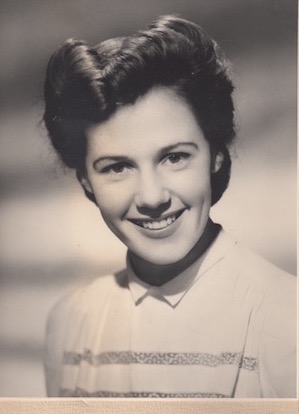
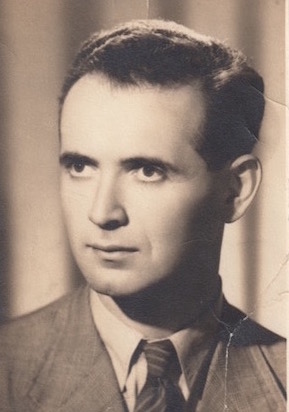
Our mother's sister, Marge, who had been close to marrying an American Serviceman during the war, had had a whirlwind romance with George Rostos, a Hungarian Jew, who had emigrated to Australia during the war. His parents, who were later to join him and Marge in Australia, had been in a Nazi concentration camp. George and Marge were married in 1945, the year the war ended.
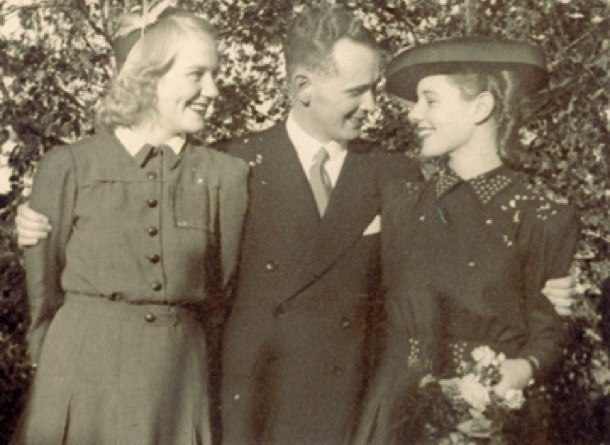
From left: Alice, George and Marge
Jim and Alice, our parents, were married later the same year. A busy year, as in October of that same year, George was offered a job in Sydney at the CSIRO. It was an exciting and welcome offer but it led to “a great family sorrow” as George and Marge moved to Sydney. They travelled to their new life on The Spirit of Progress, then a steam train.
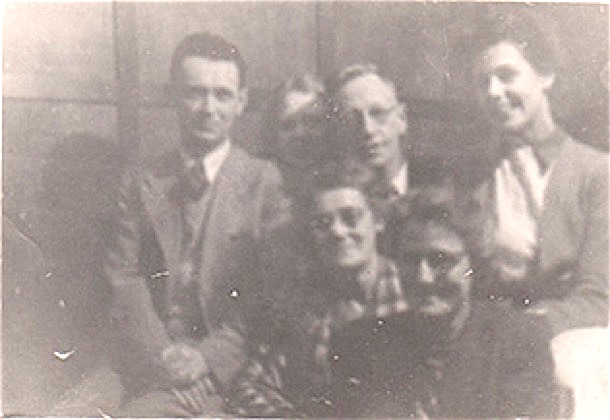
The family gathering the night before. From left: George, Alice, Freda, Alf, Auntie Bert and Marge.
To us in the world of instant communication and Skype, we may think, “What’s all the fuss about, it’s only Sydney?” But, in 1945, five months after World War 2 ended, it was quite a different matter. During the war people had not travelled much, and even long-distance train fares were expensive and airfares, prohibitive. Once the train pulled out of the station one of the few means of communication was by letter:
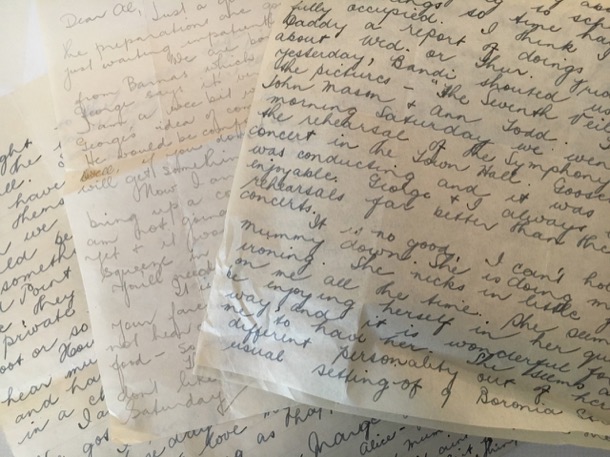
The only other means of communication was by telegram. Telegrams were expensive, as you paid per word, and therefore they were usually only used in an emergency. You would take the message to the post office where it was translated into Morse Code, and then transmitted along telegraph wires, decoded at the other end and delivered to your home by the telegram boy on his bicycle.
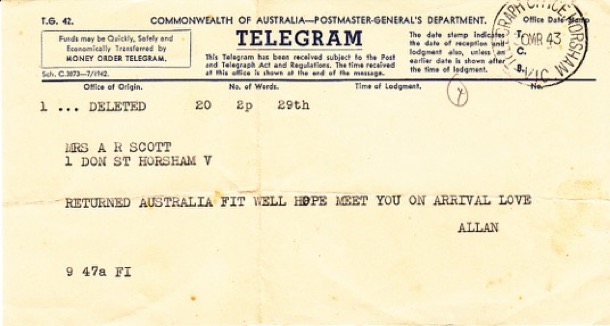
LIFE IN SYDNEY
And so began their new life in Sydney. The first three places from 1945 to 1949 were all in fashionable, post-war, cosmopolitan Sydney.
Marge and George had only known each about a year when they moved to Sydney. Marge speaks of their friendship group in Sydney as Hungarian Jewish refugees. This included Bandi, their housemate. What an amazing new world she lived in! Rose Bay and Potts Point were, and still are, in the heart of fashionable Sydney.
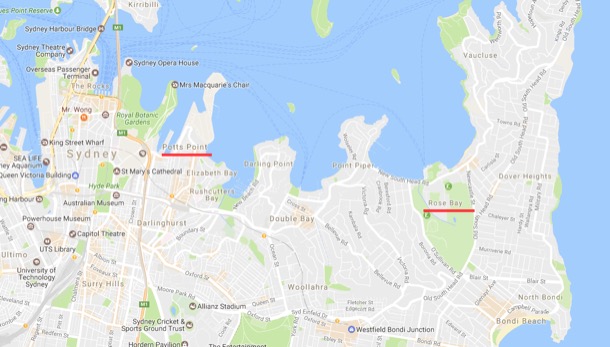
Marge speaks of watching the flying boats landing at Rose Bay. It had been a busy “airport” during the war, and, in 1945, was still used for overseas travel.
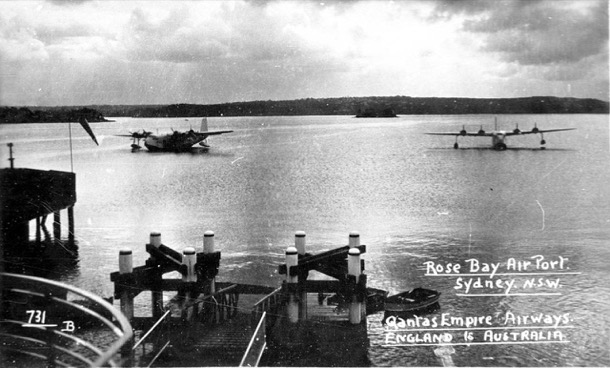
POTTS POINT
Their exciting new life continued in another inner city apartment.
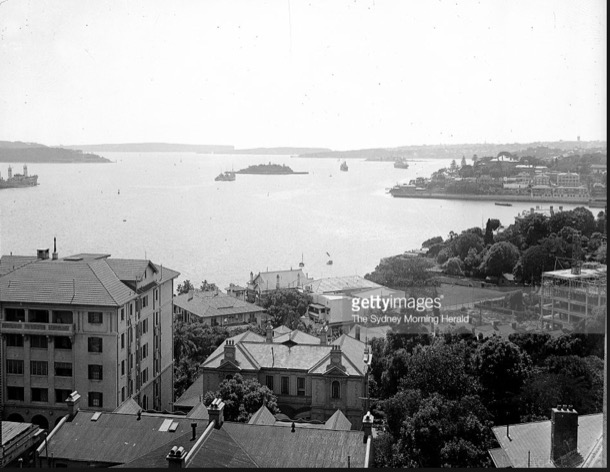
Potts Point is right on the harbour.
BELLEVUE HILL
Bellevue Hill, where Marge and George lived for three years from 1947, is in much the same area of Sydney.
They shared this flat with Phyllis, who seems to have worked in a job where she had access to otherwise unobtainable items. Marge speaks of her often in her letters.
These two extracts are from letters Marge wrote to Alice from Bellevue Hill, in 1947:
We, George, Phyllis and I, went to the beach (Tamarama) yesterday. Phyllis got let down by one of her blokes whom she had quite a crush on and she came with us. I must admit she took it with great dignity and amusement, though I know she was a bit crushed. So we sunned from 11 o'clock till 3. George and Phyll went nicely pink, but I did not change from my pale putty.
The job is still quite within my scope. I mean the two jobs. Phyllis helps a lot and, even if she is not home for dinner, never neglects to make us a delicious sweet from her American Cookery Book and peel some veggies for me.
She helps in many small ways which are not noticeable too, and I often go to do a small job to find it is already done. She brings lots of things from the planes - fruit and soap and face tissues; and brings me Persil (laundry powder) and Lux (toilet soap) and Velvet Soap (used for washing dishes, floors, surfaces, hand washing clothes etc), which have been unobtainable here for months.
This one was written acknowledging a birthday present:
I am so terribly thrilled with the cloth. When i first opened it I thought you must have got cloth at some art shop with stamped design and spoked hem and advised colours, but on reading your letter I find it is all a family affair and I am truly amazed and pleased with your taste and industry. Did you really do that spoked edge all on your own? I just love the colours, especially as my favourite colour is yellow. Thank you darling so very much. I shall cherish it and wash it so carefully and it will only be used on very special occasions. Tait also gave me a cloth - a beige one, very tasteful and good material. She also gave me a coffee pot to go with my set. Stephen left me a beautiful round cloth in Hungarian lace too, so i am not so badly off now. Phyll bought me a butter knife, a rolling pin and a beautiful round crystal bowl with two little handles and that engraved work around the sides- grape design and I love using it. I am now serving up my meals continental fashion these days, piling everything on dishes in pretty patterns and let the folks serve themselves. - It’s fun…..
…….if George were Australian I would certainly encourage him to take a job in Melbourne, but good jobs for foreigners don’t grow on gooseberry bushes. Here is an example: Last week Knox Schlapp advertised for a clerk. Several people called and one among them with a German name. I announced him to Mr Shaw who said to me, “That’s a foreign name. Is he a foreigner? I don’t want to see him.” I had to go and tell the chap to go away, and he had by far the most intelligent face of all that we interviewed. (Mr Shaw doesn’t know that George is a foreigner) They are turned down before even given the chance. Then again, George is not treated as a foreigner out there (CSIRO). In the atmosphere of prize scientific research, which exists there, such things do not matter and he is gaining the confidence and poise which he certainly would not out in the industry and commercial field.
SEVEN HILLS
Life was to change dramatically for Marge and George when they moved out of fashionable, lively Sydney into a house in a newly developed housing estate at Seven Hills, 37 kilometres west of the city.
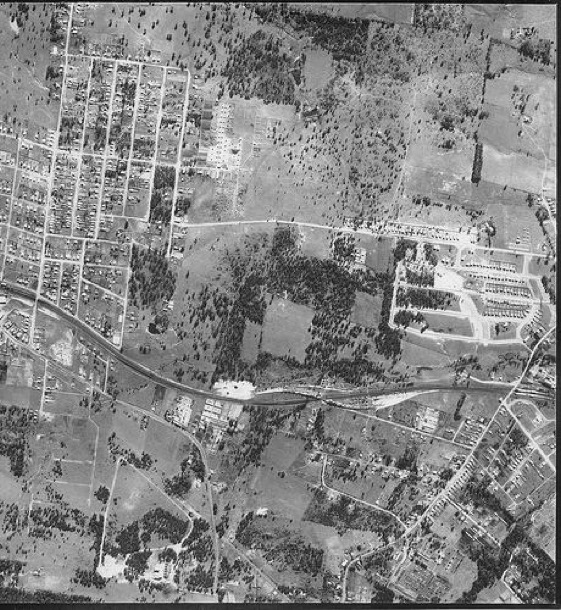
Seven Hills Estate in 1945.
It was not until the mid 1950s that George finally got a job in Melbourne CSRIO, and they all moved back to live close to their family.
War Service
Our family stories research has led to the discovery of four great great uncles: four brothers who were soldiers. They were four of the seventeen children of Martha and Joachim of Heather Farm in Wandong, about whom we wrote in "The Poor Little Thing" on June 8th, 2016 and "Heather Farm" on August 3rd, 2016. Our maternal grandfather Alf, was their nephew.
Learning their stories, imagining their experiences, fitting their details into the wider sweeps of military history has been enthralling and rewarding.
We present the four Dau (Dow) brothers, Frederick, Arthur, Charles and Walter.
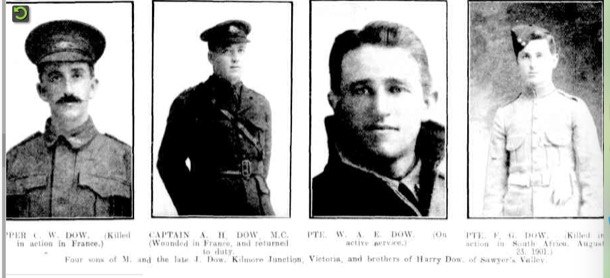
Frederick and Arthur actually enlisted as Dow, an anglicised version of Dau. It is a constant confusion.
PRIVATE F. G. DOW
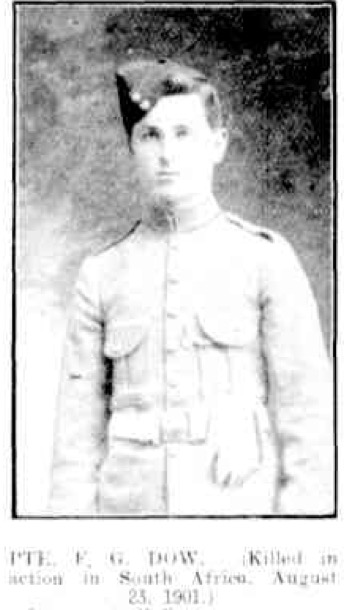
Australia was twenty-eight days old when nineteen year old Frederick sailed on The Orient out of Melbourne, bound for South Africa and the Boer War. His company was the Fifth Victorian Mounted Rifles.
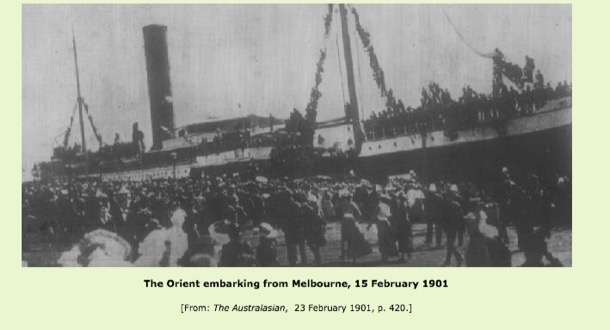
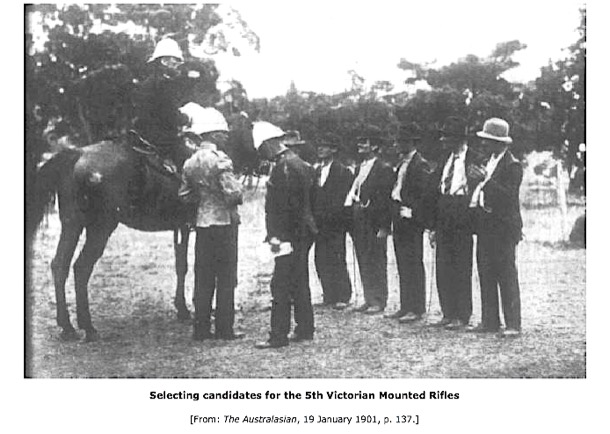
Britain had colonised the southern part of South Africa eighty years earlier and had had an uneasy relationship with the other colonisers of this area, the Dutch Boers, who had been there for a hundred and fifty years longer. Tensions had escalated to war in 1899, and the British Empire was required to send troops to participate.
By 1901, the war had become a drawn out guerrilla affair mostly in the desert-like Transvaal area with small groups of Boer soldiers attacking and then disappearing back into the harsh dry landscape.
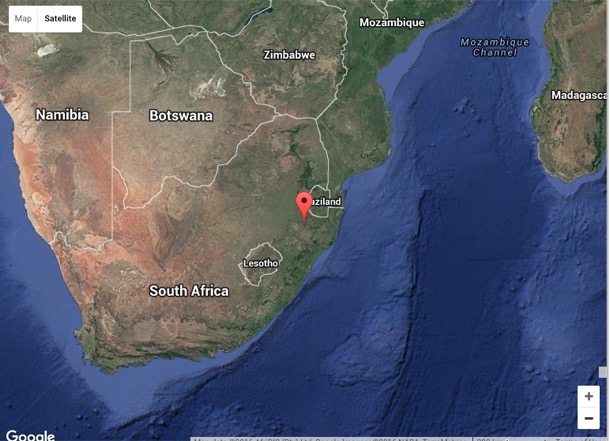
Many of the “colonial” troops, like Frederick were bushmen, tough, self reliant and skilled at shooting from horseback: exactly the set of skills needed for this type of warfare. But it was very hard on men and horses alike. Most of the fighting took the form of small skirmishes, but sometimes the men had to attack remote farmhouses, confiscate the livestock, destroy the farms and escort the women and children to the notorious concentration camps where thousands died. R G Keys of South Moorabbin wrote of making captures of large numbers of prisoners and cattle and having brought in large numbers of Boer families. “We have also burnt thousands of acres of grass and a number of farms and have destroyed everything of any use to the Boers.”
They spent long periods in the saddle with few opportunities to bathe or change their clothes; lice were a constant problem. Temperatures on the veld ranged from relentless heat during the day to freezing cold at night.
Private F W Collins wrote, “What I can see of the war is that the Boers can keep it on as long as they like, the only way is to starve them out. They get right in the mountains, and there are bullets whizzing about you and you cannot see any enemy. We are going from daylight till dark, up at 4 o’clock in the morning, and it is sometimes midnight before we get in again, so you can imagine we feel quite knocked out. When I get back to old Victoria I’ll do nothing but sleep.”
We don’t have much detail about Frederick’s death, but Lord Kitchener, Field Marshall in charge of the war, reported in one of his dispatches: "on the 23rd August Lieutenant Colonel Pulteney had a sharp engagement with the enemy on the west side of the Schurveberg, in which the Victorian MR (Mounted Rifles) had 2 men killed and 5 wounded.” One of those two men killed was Frederick Dow.
Two years later, his mother, Martha, and brother Harry inserted this memorial in the local paper:
In loving memory of dear Fred, who was killed in battle near Vryheld, South Africa, August 23, 1901; aged 19 years and 6 months.
Tis two sad years ago today,
The trial was hard, the shock severe,
To part with one we loved so dear.
He is gone, but not forgotten,
Never shall his memory fade;
Sweetest thought shall ever linger
Round about our soldier’s grave.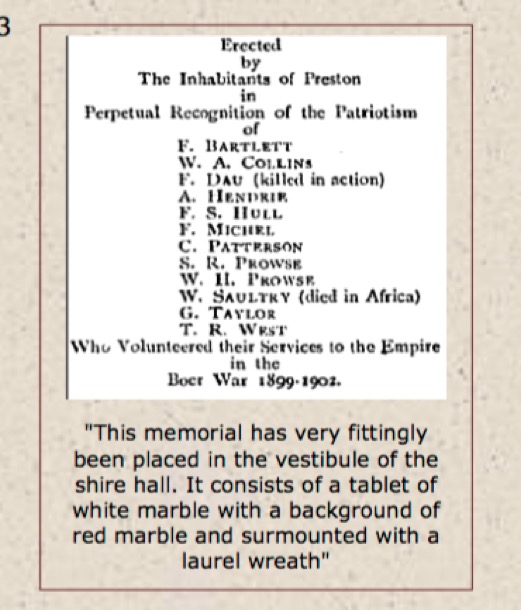
MAJOR A. H. DOW
Arthur was on one of the first ships to leave Melbourne for the war. He sailed from Station Pier Melbourne on the Orvieto on October 21st 1914. There were huge crowds to wave off this first wave of volunteers.
Soldiers from the Orvieto disembarking at Egypt: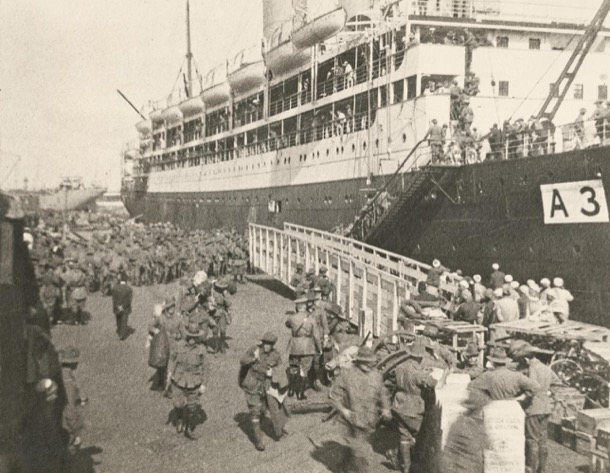
Arthur was a career soldier. He had joined up as a military engineer, aged seventeen in 1908 and had already been promoted to Warrant Officer.
Like all of those first soldiers, after a short time in Egypt, Arthur was dispatched as part of the Mediterranean Expeditionary Force to what would become known as Anzac Cove, Gallipoli. He was there for the very first Anzac Day landing, but went ashore “several days” later. He must have watched from his ship as the first few waves of shore boats struggled amid Turkish bullets and shells that rained down from the cliffs. By the time it was his turn, things were still very chaotic and dangerous. It took ten days for the troops to be safely dug in.
On June 16th, he was Injured and was treated at the hospital on the Greek island of Lemnos.
He went back to Gallipoli ten days later.
At the beginning of August, Arthur was detached for duty to Assistant Adjutant General 3rd Echelon in Alexandria (which dealt wth military discipline, though he was in the “records section&rdquo![]() .
.
By March 1916 he was with the Fourth division engineers at the huge Anzac training area near Cairo, called Tel-el-Kebir, a six mile long “tent city”, where he was promoted to 2nd Lieutenant.
He must have participated in the notorious three day march across the desert in searing heat to Serapeum, on the Suez Canal.
Here there was more training, in preparation for the move to France, and he was promoted again to Lieutenant. On June 2nd, he travelled on the ship “Kinsfaun Castle” to Marseilles, in the south of France.
The next mention in Arthur’s record is six months later, in January 1917, where he is “mentioned in despatches” (a sort of honour) and then again on June 26th, where he is promoted to Captain.
We know what he was involved in during those couple of years in France and Belgium because we know what unit he was in.
He fought at Ypres and Messines Ridge and Passchendael: all infamous places in the history of the first world war.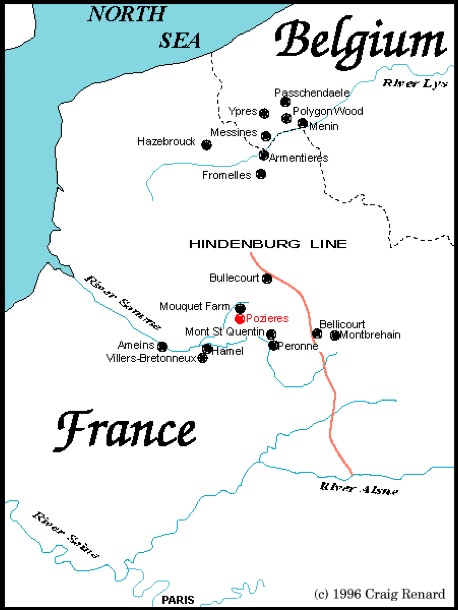
It was for his work from 24th September through to 24th October that he was awarded the Military Cross.
Arthur was a military engineer. Engineers, also known as sappers, were essential to the running of the war. Without them, other branches of the Allied Forces would have found it difficult to cross the muddy and shell-ravaged ground of the Western Front. Their responsibilities included constructing the lines of defence, temporary bridges, tunnels and trenches, observation posts, roads, railways, communication lines, buildings of all kinds, showers and bathing facilities, and other material and mechanical solutions to the problems associated with fighting.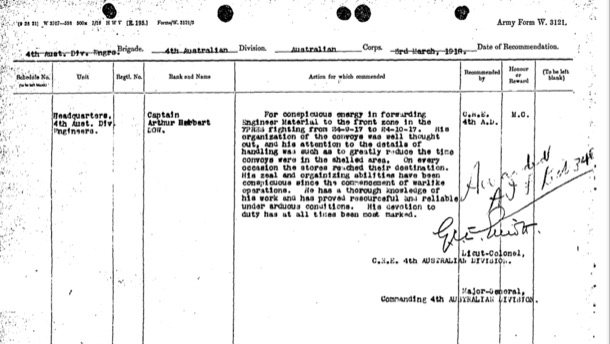
At the time Arthur won the Military Cross, the 4th Division was involved in the battle of Polygon Wood and then the third battle of Ypres, Passchendaele. It is from the Ypres-Passchendaele area that we get the iconic images we have of trench warfare in a landscape of deep mud and water filled shell holes with broken off toothpick trees, stretching away into a hazy distance; where falling off the duck board paths meant drowning in mud. By the time Passchendael was captured in November 1917, the Australians had fought for eight weeks and suffered over 38 thousand casualties.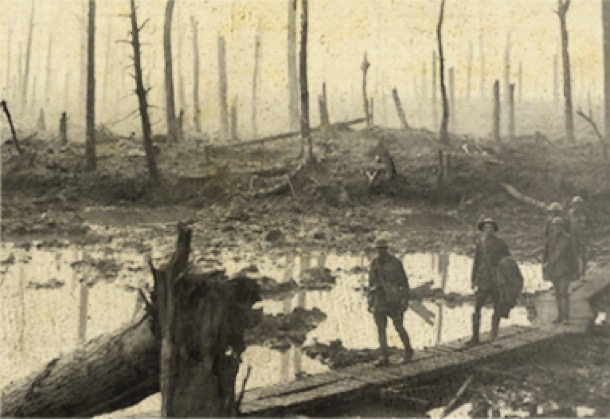
At the beginning of December Arthur had a fortnight’s leave in Nice, Italy and on his return he was sent to England to Brightlingsea to train engineers. It must have been a welcome break, but he was back in France by May, 1918.
He was wounded in action on August 8th. At that time his company, the 14th Field Company Engineers was laying wire barriers across the area to be advanced upon in front of the village of Villers Brettoneux. They were harassed by constant German shellfire, and snipers.
The resulting battle was called the Battle for Amiens, and was a resounding success, although between August 7th and 14th, the Australians lost six and a half thousand men.
Arthur left for Australia on September 27th, and within six weeks the war was over.
He remained in the services for a few years. In 1920 he had a few months’ successful treatment for “depression and irritability”. On his application form, where he had to provide supporting evidence for his entitlement to this help, he wrote a single word: “Anzac”.
By 1940, one year into the second world war, Arthur, who had been working in a Government desk job in the civil service, rejoined the army as a Major. He was 49, married with two children, and living in St Kilda.
His war this time, was fought at a desk, sometimes in the Middle East and sometimes back in Australia. His war record mentions positions like “Hiring and Claims”, “Accomodation and Quartering”. He left finally in October 1945, aged 54. During this time he had treatment for an affected patch of skin in his mouth. The doctor mentions that this is the spot where Arthur’s pipe customarily sits.
The last mention of Arthur in the war record is application for repatriation consideration for a minor health issue. He was a healthy 72 and living in Boronia.
SAPPER C.W. DAU (DOW)
Like his brother Arthur, Charles enlisted as a sapper, or military engineer. He joined up in February 1916 in Hamilton, where he had been working as a railway “ganger”. He was thirty, slim, fair haired and blue eyed and was married to Edith, who was still back in Wandong with their three children.
He left for Europe in April and by October had joined the Second Division in Belgium, before marching to the Somme area in France. His division was involved in attacks on a collection of German trenches known as The Maze,
The main Somme fighting came to an end on 18 November in the rain, mud, and slush of the oncoming winter.
Over the next months, winter trench duty with its shelling and raids became almost unendurable and only improved a bit when the mud froze hard. The wet and the cold made life wretched. Respiratory diseases, “trench foot” – caused by prolonged standing in water – rheumatism and frost-bite were common. Many survivors would later say that this was the worst period of the war and that their spirits were never lower. Large-scale fighting did not resume until early 1917 when spring approached and a German offensive re-took areas previously heavily fought for.
Charles remained with the sixth field company, second division throughout. By the middle of 1917, they were in action in the mud at Passchendaelle. Charles’ brother Arthur was there too, with a different division. Eight weeks of heavy fighting took a huge toll on Australian troops.
At the end of 1917, he had a three week leave in England, returning to his unit in December, just in time for the German Spring Offensive, aimed at retaking Ypres in Flanders. The second division were involved in Messiness until March and then the battle of Lys in April. In June they participated in the very successful Battle of Hamel.
The Allies finally began to push the Germans back. Charles was involved in the Battle of Amiens and other attacks from the village of Villers-Bretonneux.
Then, on July 23rd, after weeks of very heavy fighting, Charles was affected by a mustard gas shell.
A letter to his wife, Edith, written in August the following year explains the story from here: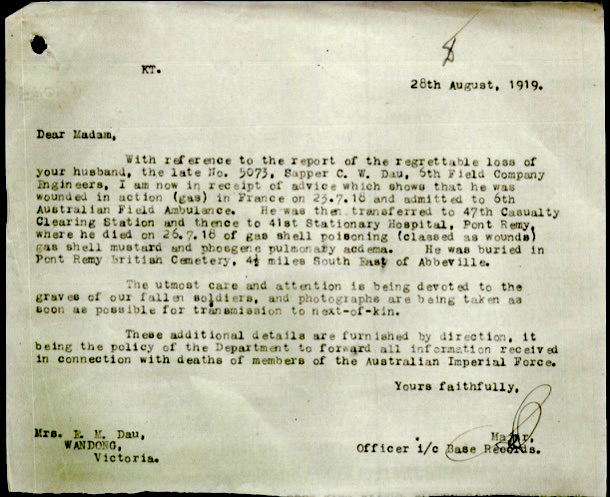
Edith received a parcel containing Charles' last few possessions: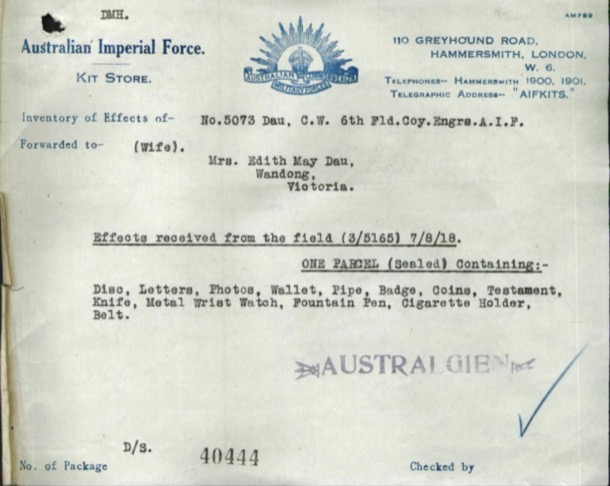
From Charles' military record: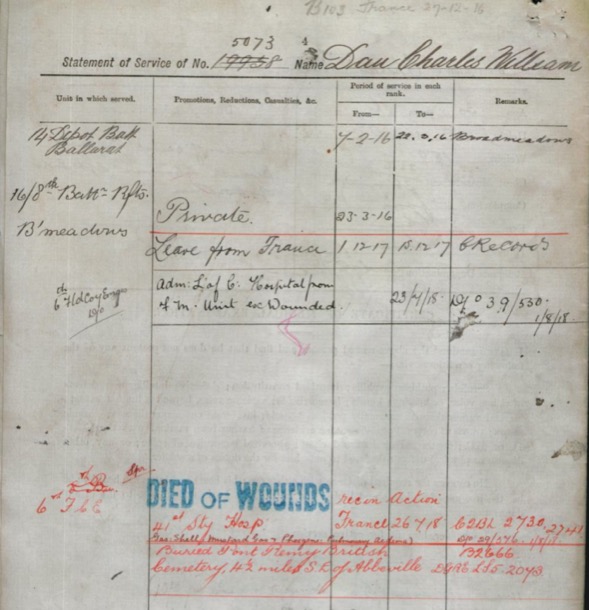
Mustard Gas
Chemical weapons were first used in World War I. They were primarily used to demoralize, injure, and kill soldiers in trenches, against whom the indiscriminate and generally very slow-moving or static nature of gas clouds would be most effective. 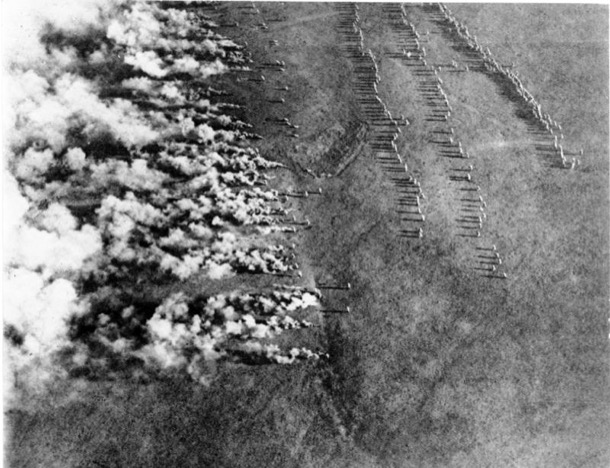
Some gases used actually killed soldiers, but mustard gas was more a disabling chemical. On initial exposure, victims didn’t notice much except for an oily or “mustard” smell, and so the first men exposed to this “mustard gas” did not even don their gasmasks. Only after a few hours did exposed skin began to blister, as the vocal cords became raw and the lungs filled with liquid. 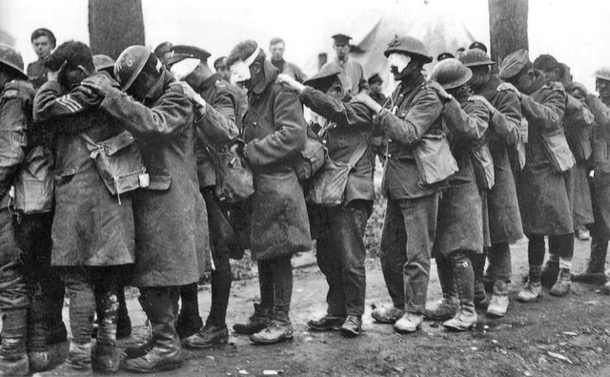
Even if they did have their masks on, they developed terrible blisters all over the body as the gas soaked into their woollen uniforms. Contaminated uniforms had to be stripped off as fast as possible and washed - not exactly easy for men under attack on the front line.
Affected soldiers died or were rendered medically unfit for months, and often succumbed years or decades later to lung disease.
As the war went on both sides used various protective masks, and gas became less effective as an actual weapon, though its psychological power was enormous and both sides continued to use it . By 1918, one-third of all shells being used in World War I were filled with poison gas.
One nurse, wrote in her autobiography, "I wish those people who talk about going on with this war whatever it costs could see the soldiers suffering from mustard gas poisoning. Great mustard-coloured blisters, blind eyes, all sticky and stuck together, always fighting for breath, with voices a mere whisper, saying that their throats are closing and they know they will choke."
PRIVATE W.A.E. DAU (DOW)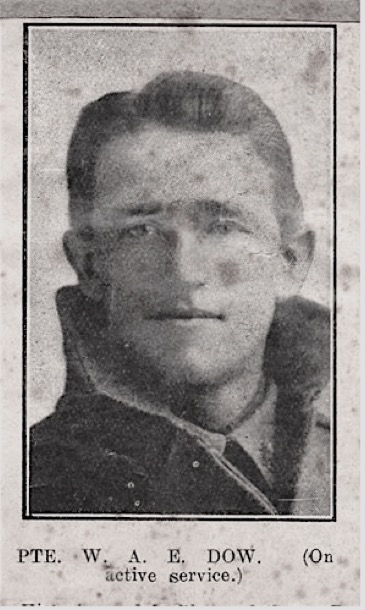
Walter Albert Edward Dau the third youngest and according to Marge and Alice ‘the black sheep of the family’ enlisted in the AIF in November !916. Wally’s medical record describes him as having fair hair and blue eyes. He was twenty-seven, unmarried and a motor driver by occupation. He sailed for England in March 1917 with reinforcements for the 21st Infantry Battalion and he returned to Australia in October 1922, where he was discharged from the Army in December of that year. On the tapes Marge and Alice recall that he was apparently a bit bookish and lived ‘as a bit of a hermit in Noogee.’ He died in 1974 maybe in Queensland.
Wally arrived in England and was initially based at Rollerstone a huge Army camp on the Salisbury plain. New arrivals were sent here and the placed in other training camps nearby. Between stints in hospital, Wally was assigned to the 6th Signals Battalion and then after a final few months at Grantham Military Hospital was trained as a machine gunner. Wally spent almost sixteen months moving between training facilities and several military hospitals. 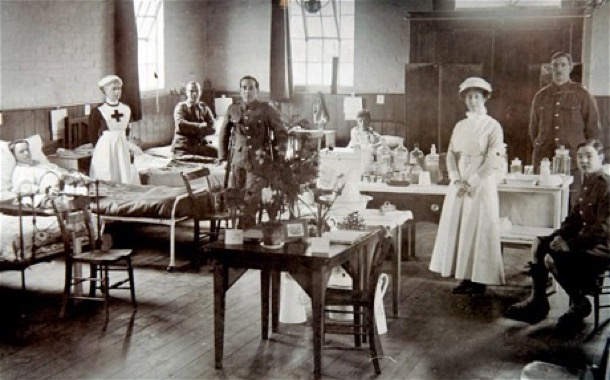
The handwritten records mention Synovitis a painful, chronic inflammation of the joints, a ganglion on his arm and ‘Hysteria NYD’ [Not Yet Diagnosed]. While Wally was undergoing one of his hospital stays, his brother Charles was gassed and died in France. Finally in October 1918 Wally was transferred to the Machine Gun Corps, 21st Battalion and he was on track to go to France. Fate intervened and Wally sailed to France on the 28th of November, seventeen days after the war ended.
It is difficult to know why Wally was so long in England, but one month after Armistice, Wally was in France with the AIF Graves Unit. The Commonwealth Graves Commission had already been established in response to the public's reaction to the enormous losses in the war. Their work in France was to ensure that the final resting places of the dead would not be lost forever.
From the very first battles in the early weeks of the fighting on The Western Front, the number of military dead was already in the tens of thousands. Graves and burial grounds situated in the area of a battlefront were often damaged by subsequent fighting across the same location, resulting in the loss of the original marked graves. 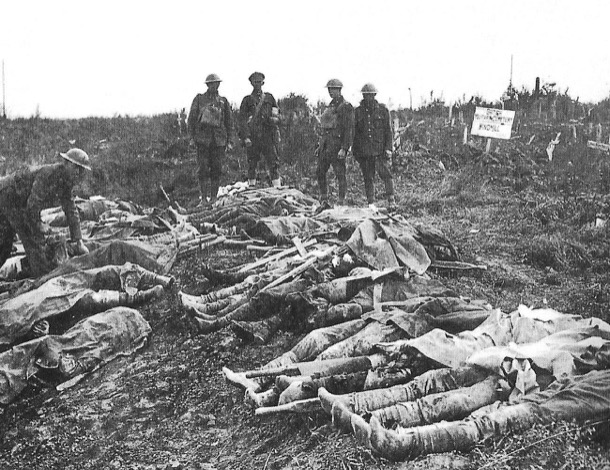
Some bodies simply could not be retrieved from underground.
Added to this, the technical developments in the weaponry used by all sides frequently caused such dreadful injuries that it was not possible to identify or even find a complete body for burial.These factors were generally responsible for the high number of “missing” casualties on all sides and for the many thousands of graves for which the identity is described as “Unknown”. The AIF War Graves Unit was responsible for the cataloguing of the dead and the construction of the monuments and cemeteries. 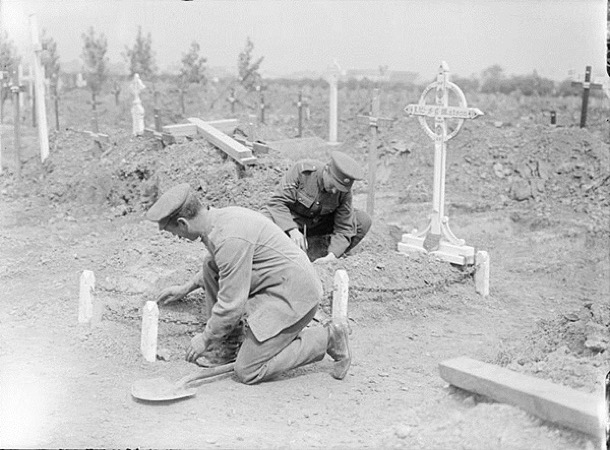
One wonders what Wally's reaction was to this overwhelming task.
Wally, however found distractions. He had a daughter!
Amongst his military records is a translation of a letter written in 1933. The letter is from Madame Thomasson of Avignon France.
‘Please inform me where to write to Walter Dau, Australian subject’ involved in “War Grave Construction work in Belgium, who sailed from England to Australia in 1922. I should be very much obliged if you would supply me with information as to the whereabouts of this person who is the father of my daughter, ……. in order to define her position and nationality.’
The letter may never have reached Wally as it was passed between the Defence Department and Australia House, London with no record of delivery or response.
Another distraction for young Wally was 42 days of incarceration after he was Court-martialled for: ‘Conduct to the prejudice of good order and military discipline in that he ……was carrying food, the property of civilians a motor lorry, without authority’
Wally pleaded Not Guilty but the charge was upheld. 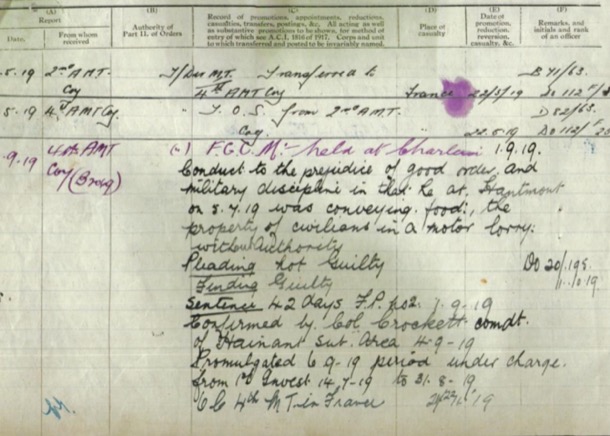
An interesting young man, many unanswered questions and a very different story to that of his two brothers who were in France during the fighting.

